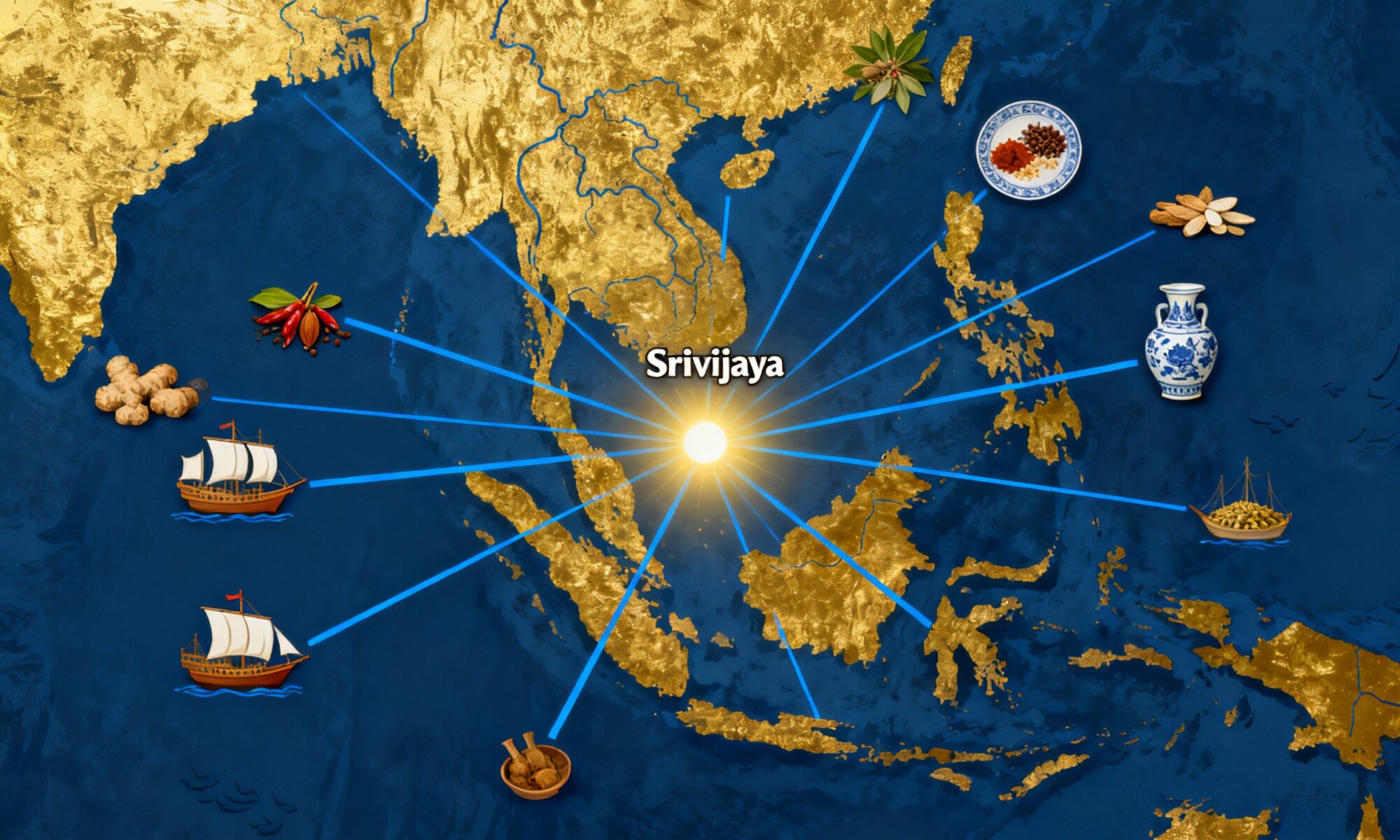The Rise of a Thalassocracy
In the 7th century, the world was on the move. The Tang Dynasty in China was a stable, cosmopolitan powerhouse with an insatiable appetite for exotic goods. The Abbasid Caliphate was rising in the west, connecting trade from the Mediterranean to the Indian Ocean. The sea routes between them were buzzing with activity, and Srivijaya, based in what is likely modern-day Palembang on the island of Sumatra, was perfectly positioned to take advantage.
But geography was only half the equation; strategy was the other. Srivijayan rulers recognized that controlling a single port wasn’t enough. To achieve true dominance, they had to control the entire waterway. They accomplished this through a brilliant and ruthless model centered on their powerful navy, manned by the legendary orang laut, or “sea people.” These nomadic seafaring communities knew the straits’ every shoal, current, and hidden cove. Allied with the Srivijayan throne, they became the empire’s enforcers.
A merchant ship entering the Strait of Malacca had two choices: either fall prey to independent pirates or accept the “protection” of the Srivijayan navy. This protection came at a price. All ships were compelled to dock at the capital, a bustling river-port teeming with foreign traders. Here, they would pay tolls and taxes, and the Srivijayan court would act as the sole broker for the region’s most valuable commodities.
The Gilded Port: Wealth and Culture
Srivijaya became an unimaginably wealthy entrepôt, a mandatory stop for all east-west trade. Its genius was in its monopoly. By forcing all trade through its port, it could control supply and demand, setting prices for the coveted goods that passed through its territory. Picture the scene in Palembang’s harbor:
- From China: Junks laden with fine silk, delicate porcelain, and ironware.
- From India: Ships carrying vibrant cotton textiles, beads, and ivory.
- From the Middle East: Dhows bearing fragrant frankincense, myrrh, glassware, and Arabian horses.
- From the Indonesian Archipelago itself: Srivijaya controlled the source of precious spices like cloves and nutmeg from the “Spice Islands” (the Moluccas), along with aromatic sandalwood, camphor, and exotic animal products.
This immense wealth funded not just a powerful military, but a sophisticated cultural and religious center. Srivijaya became one of the most important hubs for the study of Mahayana and Vajrayana Buddhism outside of India. The famous Chinese Buddhist pilgrim, Yijing, made two extended stays in Srivijaya in the late 7th century on his way to and from the great Indian university at Nalanda. He was astounded by what he found, writing that Srivijaya hosted over a thousand Buddhist monks and that its level of Sanskrit scholarship was so high that Chinese monks should study there for a year or two before proceeding to India. The empire’s religious prestige gave it immense “soft power”, attracting pilgrims and scholars and cementing its reputation as a great civilization.
The Vanished Metropolis: An Empire Built on Water
For an empire that was so powerful and lasted for centuries, Srivijaya presents historians with a frustrating puzzle: where are the grand monuments? Unlike the Khmers who built Angkor Wat or the Sailendras who erected Borobudur in nearby Java, Srivijaya left behind no magnificent stone temples or sprawling palace ruins. Why?
The answer likely lies in its very nature as a maritime state. Arab and Chinese travelers described the capital not as a city of stone, but as a “city of water.” The ruler and his court lived in a palace on the riverbank, but the vast majority of the population lived in houses built on stilts over the water or even on floating rafts and boats. It was a fluid, amphibious capital, perfectly adapted to its riverine environment. While practical, this meant that nearly every structure was built from perishable materials like wood, bamboo, and thatch. Over the centuries, in the humid tropical climate, the entire metropolis simply rotted away, leaving only scattered inscriptions and a treasure trove of sunken ceramics for archaeologists to find.
The Unraveling of an Empire
No empire lasts forever, and Srivijaya’s dominance began to fray in the 11th century. Its power was entirely dependent on its ability to enforce its monopoly. When that control was challenged, the system collapsed.
The Fateful Blow: In 1025 CE, the empire suffered a devastating blow from an unexpected direction. Rajendra Chola I, the ambitious king of the Chola dynasty in southern India, launched a massive and unprecedented naval raid across the Bay of Bengal. His fleet sacked Palembang and other key Srivijayan ports, even capturing the Srivijayan king. While the Cholas did not occupy the territory, the attack shattered Srivijaya’s reputation as an invincible naval power. The spell of absolute control was broken.
Following the raid, rival ports in Sumatra and the Malay Peninsula grew bolder, beginning to compete for trade and chipping away at Srivijaya’s monopoly. The rise of powerful Javanese kingdoms, particularly the Majapahit Empire in the 13th century, marked the final decline. Environmental factors, such as the silting up of the Musi River that made the capital less accessible to large ships, may have also played a role.
The Legacy of the Choke Point Kings
By the 14th century, the Srivijaya Empire had faded into history, its name almost entirely forgotten until it was rediscovered by 20th-century scholars. Yet, its legacy endured. It created a blueprint for maritime power in Southeast Asia, one based on trade control, naval supremacy, and cultural diplomacy. The successor state, the Sultanate of Malacca, adopted and perfected Srivijaya’s model in the 15th century, once again turning the strait into a source of incredible wealth.
The story of Srivijaya is a powerful reminder that history’s greatest empires are not always the ones that leave the largest ruins. Sometimes, they are the ones who master the currents of trade, control the world’s most vital choke points, and, like a great ship, leave only a faint wake on the waters of time.
